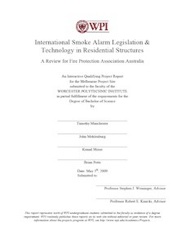







WPI Smoke Alarm Legislation
& Technology Study
Download
Here > > >


WPI Study, ‘Executive Summary’ page x, para 1
Combination Ionization/Photoelectric Smoke Alarm Technology
WPI Study, 4.1.3, ‘Combination Alarms’, page 26, para 2

WPI Study, 4.1.8, ‘Conclusion’, page 35, para 1


Founded in Worcester, Massachusetts, USA, in 1865,
WPI is one of America’s oldest technological universities.




Scroll to see all 111 pages:





(c) Copyright 2010 The World Fire Safety Foundation | Last Updated: 18 August, 2010 | Privacy Policy | Disclaimer | Search WFSF site
For errors on, or suggestions for this ‘pump’ webpage, contact the WFSF WebMaster | Supporters | About | Media